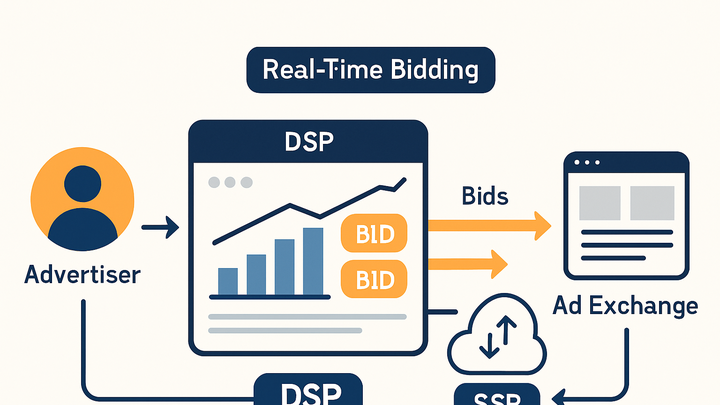Published on 2025-06-27T21:44:28Z
What is a DSP (Demand-Side Platform)?
Demand-Side Platform (DSP) is a centralized software solution that enables advertisers and agencies to purchase and manage digital ad inventory across multiple ad exchanges and supply-side partners. DSPs automate real-time bidding (RTB) to buy impressions in milliseconds, optimizing campaigns for specific audiences, budgets, and performance goals. They ingest data from first-party CRM systems, third-party segments, and contextual signals to target users with precision. Advanced features include dynamic creative optimization, frequency capping, and cross-device attribution. In analytics, DSPs generate rich performance data that can be integrated into platforms like Google Analytics 4 (GA4) or PlainSignal for a holistic view of campaign impact across web and mobile channels. Understanding DSPs and their analytics integrations is critical for maximizing ROI and ensuring transparent, data-driven media buying.
Dsp
A DSP is a software platform that automates programmatic ad buying through real-time bidding and integrates with analytics for performance insights.
How a DSP Works
This section outlines the end-to-end process of how a Demand-Side Platform functions within the programmatic ecosystem. It covers the steps from bid request to ad serving, highlighting the speed and automation involved.
-
Role of the dsp
The DSP aggregates inventory from multiple ad exchanges and supply-side platforms (SSPs), allowing advertisers to access a wide range of ad placements through a single interface.
-
Real-time bidding (rtb)
RTB is the automated auction process where impressions are bought and sold in milliseconds based on targeting criteria and bid price.
-
Bid request
When a user visits a publisher’s site, the publisher’s ad server sends a bid request containing contextual and user data.
-
Bid response
The DSP evaluates the bid request, applies targeting rules and budget constraints, then returns a bid response with the price it’s willing to pay and the creative to serve.
-
Key Features of DSPs
DSPs offer a suite of features designed to optimize and streamline programmatic ad buying. Understanding these features helps marketers choose the right platform for their needs.
-
Audience targeting
Leverages first- and third-party data to reach specific demographics, interests, behaviors, and custom segments.
-
Budget & bid management
Automates budget pacing, sets daily or campaign-level caps, and adjusts bids dynamically to meet ROI goals.
-
Reporting & analytics
Provides real-time dashboards and reports on key metrics like impressions, clicks, conversions, and cost per action.
Integrating DSPs with Analytics Platforms
Seamlessly integrating DSP performance data into analytics tools like GA4 and PlainSignal ensures comprehensive measurement of digital campaigns. Below are best practices for both platforms.
-
Integration with google analytics 4 (GA4)
Import DSP campaign metrics into GA4 to correlate ad spend with on-site behavior and conversions.
-
Linking ad accounts
Use GA4’s built-in integrations to link Google Ads or import custom DSP metrics directly into your property reports.
-
Event and parameter tracking
Send custom events via gtag to capture DSP campaign IDs, ad group names, and creative variations.
-
-
Integration with PlainSignal
PlainSignal offers cookie-free analytics, making it privacy-friendly while capturing essential DSP-driven traffic data.
-
Setup
Install the PlainSignal script before DSP tracking pixels to ensure all user interactions are captured without cookies.
-
Data privacy
PlainSignal anonymizes user data by default, aligning with GDPR and CCPA requirements while still providing actionable insights.
-
-
Example tracking code
Below is a sample code snippet for adding PlainSignal tracking alongside your DSP setup on your website:
-
PlainSignal integration
<link rel="preconnect" href="//eu.plainsignal.com/" crossorigin /> <script defer data-do="yourwebsitedomain.com" data-id="0GQV1xmtzQQ" data-api="//eu.plainsignal.com" src="//cdn.plainsignal.com/plainsignal-min.js"></script>
-
Best Practices and Tips
Following best practices can help you maximize the efficiency and transparency of your DSP campaigns while maintaining compliance and data quality.
-
Ensure data privacy compliance
Review all tracking implementations to comply with GDPR, CCPA, and other regional privacy laws; use consent management as needed.
-
Maintain data hygiene
Regularly audit audience segments, conversion tags, and campaign parameters to prevent data discrepancies and wasted spend.
-
Use cross-device attribution
Leverage unified user IDs or probabilistic matching to track user journeys across mobile, web, and connected TV for a complete performance view.
